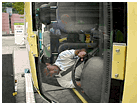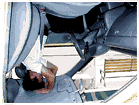
This roll-over simulator (using a Nissan March) was created for our course by the SONPO Safety Driving School (sponsor: Marine & Fire Insurance Association of Japan, Inc.). The simulator, the first in Japan to use a real car, enables students to safely experience what it is like to be inside a car while its rolling over and while its upside down.

The simulator platform is placed under the car chassis and the entire car is tipped over slowly to simulate a roll-over car crash. The rotation can be stopped and locked in at any angle. The simulator electric motor draws a 100-volt household current so the roll-over simulation location is not limited by the need to access a special power source.

When the roll-over simulator banks the car (to about 20 degrees) the students find out that their seat belts do indeed work in way to save their life that they never dreamt possible. The students can experience the protective function of seat belts even in cases where the car rolls over completely. The students learn that seat belts work under these extreme conditions and this help them to fully understand their importance.
Even though the wearing of seat belts in rear passenger seats is not required under Japanese law, the simulator helps students understand why wearing them even in the back seat of cars is necessary. For parents, the simulator raises their level of awareness of the importance of seat belts in child safety (children often ride in the back seats of cars), as well as the correct fitting of child car seats (such car seats were recently made compulsory under Japanese law). The simulator is also an effective tool for helping student understand the relationship between seat belts and supplemental restraintsystem (SRS) airbags.

Course progress and instruction is carried out by full-time instructors in an easy-to-understand manner, enhancing the level of interest and comprehension of course participants.
|
![]()

